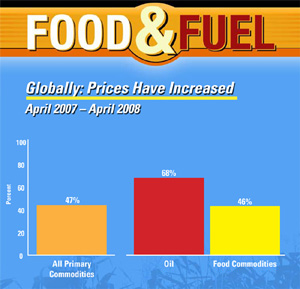 This week is the biggest week of the year for Hoosiers in Indianapolis with the 92nd Indy 500 coming up and since it is also the second year that the race will be running on 100 percent fuel grade ethanol, it’s a big week for the corn and ethanol industries in the state.
This week is the biggest week of the year for Hoosiers in Indianapolis with the 92nd Indy 500 coming up and since it is also the second year that the race will be running on 100 percent fuel grade ethanol, it’s a big week for the corn and ethanol industries in the state.
The Indiana Corn Marketing Council has been gearing up for the race with various ethanol promotions, including special discount fuel events at local fuel stations and a drawing to win a pace car Corvette. “But the real focus of this campaign is to educate the consumer about ethanol,” according to Mark Walters with the council. “What we are finding is that many consumers in Indiana are still on the fence about ethanol. They think its a good thing but they don’t know all the facts.”
 Indiana’s Hoosier Ag Today (HAT) radio network decided to find out just what consumers do know about ethanol by interviewing motorists at a recent ethanol pump promotion. Farm broadcaster Gary Truitt says he found that there is definitely a need for ethanol education.
Indiana’s Hoosier Ag Today (HAT) radio network decided to find out just what consumers do know about ethanol by interviewing motorists at a recent ethanol pump promotion. Farm broadcaster Gary Truitt says he found that there is definitely a need for ethanol education.
“Our consumer sampling seemed to support Walter’s assertion that most Hoosier motorists still have an open mind about ethanol,” said Truitt.
Among the comments Truitt heard is that ethanol is a good idea and that anything that helps reduce our energy consumption is wonderful.
Listen to Truitt’s report here or read more on the HAT website.
[audio:http://www.zimmcomm.biz/audio/hoosier-ethanol.mp3]


 A report out from accounting firm KPMG says that 60 percent of executives believe that consolidation in the renewable energy sector will continue. That’s leading to fears that a bubble may be developing in the solar, wind, and biofuel sectors as bidders compete for assets and send prices sharply higher.
A report out from accounting firm KPMG says that 60 percent of executives believe that consolidation in the renewable energy sector will continue. That’s leading to fears that a bubble may be developing in the solar, wind, and biofuel sectors as bidders compete for assets and send prices sharply higher. The National Biodiesel Board has recognized a group of U.S. Department of Agriculture researchers for finding new uses for natural glycerine, a by-product of biodiesel production, replacing glycerine made from non-renewable petroleum.
The National Biodiesel Board has recognized a group of U.S. Department of Agriculture researchers for finding new uses for natural glycerine, a by-product of biodiesel production, replacing glycerine made from non-renewable petroleum. During a Monday press conference, Secretary Ed Schafer said he had talked to the people who have “initiated these underground things that have been going on” to influence public opinion about ethanol incentives and found that while they understand that higher energy and transportation costs are the driving factor for increased food prices, they think “it’s easier” to target corn and ethanol.
During a Monday press conference, Secretary Ed Schafer said he had talked to the people who have “initiated these underground things that have been going on” to influence public opinion about ethanol incentives and found that while they understand that higher energy and transportation costs are the driving factor for increased food prices, they think “it’s easier” to target corn and ethanol.  I’m taking off for Indianapolis in about an hour. This year, I’ll be handling the Indy 500 on my own. The race isn’t until Sunday, but the
I’m taking off for Indianapolis in about an hour. This year, I’ll be handling the Indy 500 on my own. The race isn’t until Sunday, but the  On Thursday, EPIC will host the Ethanol Summit and Panel Discussion. Guest speakers include Joie Chitwood of the Indianapolis Motorspeedway, Andy Miller, director the the State Department of Agriculture, Eermson Fittipidi, a two-time Indy 500 winner, Brazilian ethanol producer and driver of this year’s felx-fuel Corvette Z06 pace car, Bill Becker, president and CEO of LifeLine Foods – the provider of the E100 racing fuel for the IndyCar Series – and more.
On Thursday, EPIC will host the Ethanol Summit and Panel Discussion. Guest speakers include Joie Chitwood of the Indianapolis Motorspeedway, Andy Miller, director the the State Department of Agriculture, Eermson Fittipidi, a two-time Indy 500 winner, Brazilian ethanol producer and driver of this year’s felx-fuel Corvette Z06 pace car, Bill Becker, president and CEO of LifeLine Foods – the provider of the E100 racing fuel for the IndyCar Series – and more. “We think the time has come for USDA to join in the public conversation about the relationship between food prices and biofuels,” said Agriculture Secretary Ed Schafer. “We want to offer our perspective and what has happened in the marketplace, to share our data and the analysis of what has happened.”
“We think the time has come for USDA to join in the public conversation about the relationship between food prices and biofuels,” said Agriculture Secretary Ed Schafer. “We want to offer our perspective and what has happened in the marketplace, to share our data and the analysis of what has happened.” The Energy Policy Act of 2005 includes provisions enabling the EPA Administrator to grant a full or partial waiver if implementation of the RFS would severely harm the economy or environment of a state, region, or the entire country, or if EPA determines there is inadequate domestic supply of renewable fuel. In consultation with the Departments of Agriculture and Energy, EPA must decide on a waiver request within 90 days of receiving it.
The Energy Policy Act of 2005 includes provisions enabling the EPA Administrator to grant a full or partial waiver if implementation of the RFS would severely harm the economy or environment of a state, region, or the entire country, or if EPA determines there is inadequate domestic supply of renewable fuel. In consultation with the Departments of Agriculture and Energy, EPA must decide on a waiver request within 90 days of receiving it. 
 The senator made the remarks during his first campaign stop in the state that is becoming a leader in wind energy production in
The senator made the remarks during his first campaign stop in the state that is becoming a leader in wind energy production in  Renewable Energy Group (REG) of Ames now runs animal fats in at least four of its seven biodiesel plants in the state, according to Gary Haer, vice president of sales and marketing.
Renewable Energy Group (REG) of Ames now runs animal fats in at least four of its seven biodiesel plants in the state, according to Gary Haer, vice president of sales and marketing.